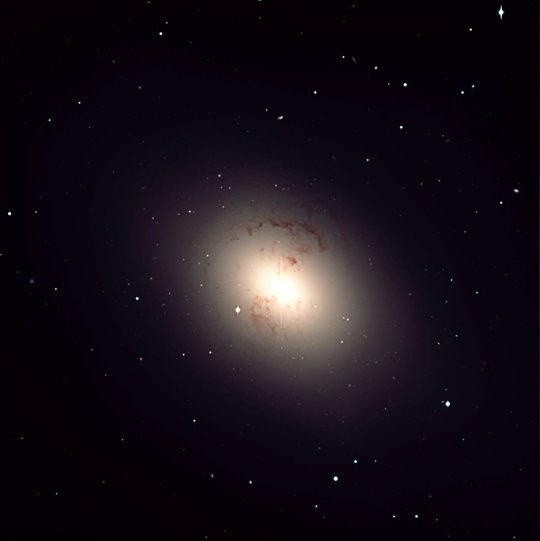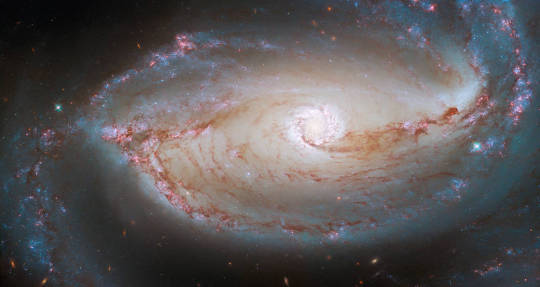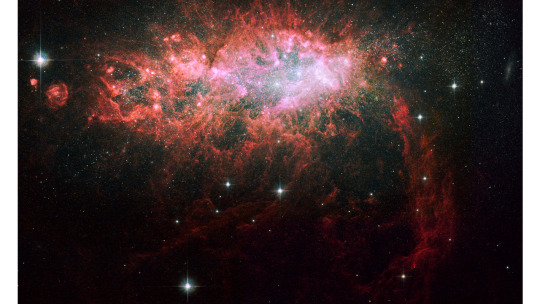#NGC 1316
Explore tagged Tumblr posts
Text

Fornax A (NGC 1316, center) and NGC 1317 (top) // Brian Diaz & Dark Matters Astrophotography
#astronomy#astrophotography#galaxy#lenticular galaxy#spiral galaxy#barred spiral galaxy#Fornax A#NGC 1316#NGC 1317#fornax
22 notes
·
View notes
Text

NGC 1316: A Tangle of Swirling Dust
by Kevin Morefield
Astronomy Photographer Of The Year
Royal Observatory Greenwich
#kevin morefield#photographer#astronomy photographer of the year#royal observatory greenwich#ngc 1316#space#nature
13 notes
·
View notes
Text

NGC 1316 taken by Hubble Space Telescope on January 26 2021
NGC 1316 is an elliptical galaxy formed by the collisions of multiple galaxies near the constellation Forax in the southern hemisphere. What makes this galaxy unique is the dark lanes of dust visible around the galaxy. These are indicative that they galaxies NGC 1316 was formed by were spiral galaxies.
What helped scientists determine that this galaxy was created due to a "recent" collision where different types of images taken of NGC 1316. Hubble's images helped to reveal huge collisional shells and a small number of globular clusters. Collisional shells are formed from debris of the parent galaxy, which under the effects of gravity and tidal forces. These tails last for a long time, before eventually being reabsorbed into the progenitor (object of origin). Globular clusters are a group of stars bound by gravity.
These two events were indicative of a merger that occurred within the past couple billion years.
#space#spaceblr#academia#stem academia#science#physics#stem student#astronomy#astrophotography#astrophysics#astronomy photography#cosmology#galaxy#galaxies#physblr#physics student#hubble telescope#hubble space telescope#eclipsellium
15 notes
·
View notes
Text
Provocan estrellas caníbales enormes explosiones en galaxia lejana
Un equipo de astrónomos del @ESO lograron captar explosiones termonucleares en la lejana galaxia NGC 1316 denominada "Stella Nova" ("nueva estrella" en latín), o simplemente "Nova".
Agencias, Ciudad de México.- Una luz tenue registrada por el Very Large Telescope (VLT)corresponde a la nova más distante observada, fruto de explosiones termonucleares en una galaxia lejana a 70 millones de años luz. Los estallidos fueron causados por el “canibalismo estelar” en sistemas binarios en los que una estrella relativamente fría pierde materia frente a su compañera más pequeña y más…

View On WordPress
0 notes
Text
Galaxy Classifications
Because space is a special interest of mine (I mean, I’m the astronomer of the collective for a reason), I thought I’d spread some knowledge. So, today we’re going to be discussing galaxy classifications, what makes each unique, and I’ll be showing some examples of each.
First of all, there are three main types of galaxies; Spiral (with barred spiral being lumped in), Elliptical, and Irregular. We’ll talk about the Elliptical first.
Class- Elliptical
An elliptical galaxy is a galaxy that takes on a stretched out circle-like appearance, like an ellipse, hence the name. It’s unclear how common elliptical galaxies are, since they contain far less gas and dust than spirals, which are known for being hotbeds of star formation, and therefore fewer new (and brighter) stars are born in these galaxies. The majority of stars are much older and give off dimmer red light, and as a result, it’s tougher to see elliptical galaxies.
Example:

This is NGC 1316, an elliptical galaxy in the Fornax star cluster. Note how dim the light is around everything but its center, and how little dust there is, save for the black streaks around the inner ‘disk’ nearest the core. Given these characteristics, it becomes pretty clear why it takes longer for us to find them.
Sometimes we find elliptical galaxies that came about as a result of two spirals crashing into each other over billions of years.
Example:

Notice the two different cores of what used to be spiral galaxies. These are NGC 2292 and 2293, two spiral galaxies that collided in Canis Major, and flung their stars, gas and dust outward (note the ring of dust on the outer edge of the galaxy) and created an elliptical galaxy.
Class- Spiral Galaxy
Next, let’s talk about spiral galaxies. Everyone knows what a spiral looks like. It’s a pinwheel, with several self-perpetuating, long lived spinning arms and contains plenty of newborn and young stars, as well as a large enough amount of gas and dust to fuel star birth. Our own Milky Way is a spiral galaxy, as is the well known Andromeda galaxy, which we’re currently on a course to collide with in about 4-5 billion years.
It’s estimated that about 70% of the galaxies closest to us are spirals, and they make up most galaxies we discover. Spirals are known to be star forming factories, responsible for the majority of newborn stars, and therefore shine brighter than other galaxy types with older and dimmer stars.
Example:

This is Messier 81, or M81, a spiral galaxy in Ursa Major and the largest in its group. Note the distinct arms, the copious amounts of space dust and gasses, and the much brighter, much younger stars (as recent as a few million years old) in its arms while its oldest stars remain closer to the center.
At its center is a black hole of about 70 million solar masses, 15 times bigger than our own central black hole, Sagittarius A*. You can actually see this galaxy right now, being that it’s April at the time of posting this, through binoculars. Though, it will only look like a small, dim grey smudge. A small telescope, however, would be able to see its core if you point it in the right place.
Now. Barred spiral galaxies. Simply put, they’re just spiral galaxies that have a central bar shaped arm running through the middle made of stars and tend to look a little more squished than typical spirals.
Example:

This is NGC 1097, a barred spiral galaxy in the Fornax cluster. Note the somewhat almond shaped appearance, the strip of dust and stars running across the galaxy’s center. These bars are actually found in about half of all spiral galaxies, and a recent study headed by Debra and Bruce Elmegreen and Kartik Sheth confirms that the formation of bars is a sign of a galaxy reaching full maturity as the ‘formative years’ come to an end.
Class- Irregular
And finally, we come to irregular galaxies. The oddballs of the universe that don’t look like galaxies at all. They’re called irregular, because they can’t be placed neatly into the Hubble sequence, something Edwin Hubble came up with in 1926 to categorize galaxies. Some feature some structure, like a spiral’s arm, but not enough to place them into the sequence cleanly. Most have no distinct regular shape like spiral or elliptical galaxies, with no trace of a nuclear bulge or spiral arm structure. They’re thought to be deformed spiral or elliptical galaxies, ripped apart by uneven external gravitational forces.
Example:

This is NGC 1569, a dwarf irregular starburst galaxy with constant star formation activity (as denoted by the bright pink near the ‘center’) in Camelopardalis. Note the lack of a nuclear bulge, no distinct shape, and in particular for this one, the unusual amount of star birthing activity. It’s called ‘starburst’ for how fast it puts out stars, at a rate about 10 to the third power greater than a normal galaxy.
This really is just the tip of the iceberg when it comes to exploring galaxies (I didn’t even touch on lenticular galaxies or Seyfert spirals), but I hope this little glance at the universe was informative all the same.
-Astronomer
#information#space aesthetic#modern astronomy#galaxies#spiral galaxy#elliptical galaxy#irregular galaxy#NGC 1316#NGC 2292#NGC 2293#M81#NGC 1097#NGC 1596
72 notes
·
View notes
Photo

Quiet Interaction
64 notes
·
View notes
Photo

NGC 1316
#NGC 1316#nasa#stargazing#astrophoto#astrophotography#galaxy#astronomy#universe#space#nebula#spinningblueball#thespinningblueball#milky way#milky way galaxy#milkywaygalaxy#spacephotography#nightsky#starrynight#milkywayphotography#astrophotos#starscape#star#cosmos#telescope#hubble#chandra#spitzer#hubble telescope#chandra telescope#spitzer telescope
226 notes
·
View notes
Video
Revealing the galactic secrets of NGC 1316 by European Southern Observatory Via Flickr: Countless galaxies vie for attention in this dazzling image of the Fornax Cluster, some appearing only as pinpricks of light while others dominate the foreground. One of these is the lenticular galaxy NGC 1316. The turbulent past of this much-studied galaxy has left it with a delicate structure of loops, arcs and rings that astronomers have now imaged in greater detail than ever before with the VLT Survey Telescope. More information: www.eso.org/public/images/eso1734a/ Credit: ESO/A. Grado and L. Limatola
2 notes
·
View notes
Photo

NGC 1316: After Galaxies Collide
#science#galaxies#space#astronomy#astrophotography#astrophysics#ngc 1316#merging galaxies#universe#cosmology#apod
691 notes
·
View notes
Text

The Great Barred Spiral Galaxy (NGC 1365, lower left) and the Fornax Cluster (Abell 373) // Aidan Beutel
#astronomy#astrophotography#galaxy cluster#fornax cluster#Abell 373#galaxy#spiral galaxy#barred spiral galaxy#elliptical galaxy#great barred spiral galaxy#NGC 1365#NGC 1316#fornax#eridanus
140 notes
·
View notes
Photo

NGC 1316 and NGC 1317
NGC 1316 and NGC 1317 are a pair of interacting galaxy located about 60 million light years away towards the constellation Fornax, the Furnace. NGC 1316 is one of the brightest elliptical galaxies in the Fornax galaxy cluster, and one of the strongest and largest radio sources visible from Earth.
While NGC 1317 is a small spiral galaxy with an apparently uneventful history, NGC 1316 appears to have had a turbulent life. Around the galaxy are tidal tails, stars and other bits ripped away from smaller galaxies and mixed up by strong gravitational forces. NGC 1316 also contains unusual dust lanes and small globular clusters, suggesting the annexation of a spiral galaxy some 3 billion years ago.
Image and information from ESO.
#astronomy#stars#space#ngc 1316#ngc1316#ngc 1317#ngc1317#science#galaxy#galaxies#spiral galaxy#spiral galaxies#elliptical galaxy#elliptical galaxies#interacting galaxies#merging galaxies#colliding galaxies#fornax#constellation fornax#furnace constellation#fornax galaxy cluster#galaxy cluster#galaxy clusters
16 notes
·
View notes
Photo

NGC 1316: After Galaxies Collide
Credits: IPAC/Caltech, WFPC2, HST, NASA
57 notes
·
View notes
Photo

Elliptical galaxy NGC 1316 via /r/spaceporn http://bit.ly/2wBvyDi
1 note
·
View note
Note
do you have a favorite star?
The one on my left cheek ^^!
#Im not sure if theyve put a name to that one yet#the black hole of NGC 13 something idk is also nice#pretty sure it doesnt count as a star though#ooc// NGC 1316 slaps its so prety
0 notes
Text
APOD: NGC 1316: After Galaxies Collide

Astronomers turn detectives when trying to figure out the cause of startling sights like NGC 1316. Investigations indicate that NGC 1316 is an enormous elliptical galaxy that started, about 100 million years ago, to devour a smaller spiral galaxy neighbor, NGC 1317, just on the upper right. Supporting evidence includes the dark dust lanes characteristic of a spiral galaxy, and faint swirls and shells of stars and gas visible in this wide and deep image. One thing that >remains unexplained is the unusually small globular star clusters, seen as faint dots on the image. Most elliptical galaxies have more and brighter globular clusters than NGC 1316. Yet the observed globulars are too old to have been created by the recent spiral collision. One hypothesis is that these globulars survive from an even earlier galaxy that was subsumed into NGC 1316. Another surprising attribute of NGC 1316, also known as Fornax A, is its giant lobes of gas that glow brightly in radio waves. via NASA https://ift.tt/z3vrTMl
https://ift.tt/LnpKYwD from Blogger Expedition Space: Space Launch, Events, News
0 notes
